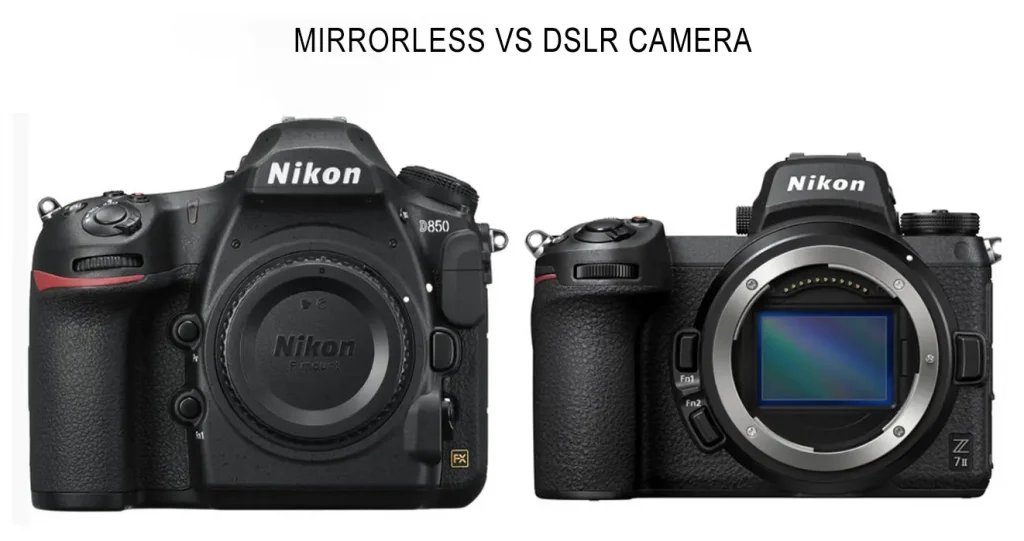
When it comes to photography, there are many different types of cameras to choose from, each with their own set of features and benefits.
We already know that digital photography has revolutionized the way we capture moments. But with so many camera options available, choosing the right one can be overwhelming, especially if you are just a beginner.
Two of the most popular choices for photographers are DSLR (Digital Single-Lens Reflex) and mirrorless cameras. I wrote this guide to help you guys navigate the key differences between these camera types and make an informed decision based on your needs.
Choosing between a DSLR and a mirrorless camera can be daunting for photographers of all levels. In this comprehensive camera comparison guide, we’ll help you understand the differences, pros, and cons of each type, so you can make an informed decision on the best camera for your needs in 2024.
Whether you are a beginner looking for your first camera or a professional seeking an upgrade, this guide covers everything you need to know.
Table of content 📷
- What is a DSLR camera?
- What is a mirrorless camera?
- Key differences between DSLR and mirrorless cameras
- Pros and cons of DSLR and mirrorless cameras
- Final words
The Evolution of Autofocus in Mirrorless Cameras
Mirrorless cameras were a game-changer when they made their debut in 2009, becoming a formidable rival to the reigning champion of photography, the DSLR. This sparked a passionate debate in the photography community as photographers weighed in on which was the better option.
The discussion is far from over as both mirrorless and DSLR cameras continue to evolve and improve with new technology advancements.
In this guide, we’ll dive into the unique features and benefits of both mirrorless and DSLR cameras. By the end of it, you’ll have a clear idea of which one is the best fit for your photography needs and desires.
Overview of Autofocus Advances:
- Recent advancements have seen mirrorless cameras surpass DSLRs in autofocus capabilities.
- These cameras now feature hybrid phase-contrast detection systems.
- AI-powered autofocus systems have become more prevalent in mirrorless models.
Key Developments:
- Improved subject detection, including human, animal, and vehicle recognition.
- Faster, more accurate autofocus in various lighting conditions.
- Increased number of autofocus points, covering more of the frame.
Impact on Photography:
- Enhanced ability to capture fast-moving subjects.
- Improved performance in low light conditions.
- Greater flexibility in composing shots with off-center subjects.
Industry Shift:
- Camera manufacturers are increasingly investing in autofocus R&D for mirrorless cameras.
- This shift reflects a broader industry trend towards mirrorless technology.
Key Considerations When Choosing:
| Factor | Details |
|---|---|
| Size & Weight | DSLR: Bulky and heavy Mirrorless: Compact and lightweight |
| Viewfinder | DSLR: Optical (direct image preview) Mirrorless: Electronic (digital image preview) |
| Autofocus | DSLR: Good, improving in newer models Mirrorless: Generally faster and more accurate |
| Lens Options | DSLR: Wide range Mirrorless: Expanding options |
| Battery Life | DSLR: Longer Mirrorless: Shorter due to EVF |
| Image Quality | Both: Excellent with large sensors |
| Video Quality | DSLR: Good, improving Mirrorless: Often exceeds DSLRs |
| Price Range | DSLR: Varies, more affordable options Mirrorless: Varies, competitive with DSLRs |
| Ergonomics | DSLR: Larger body, dedicated controls Mirrorless: Smaller, may not suit all hand sizes |
Shutter Mechanics: Mirrorless Cameras Leading Innovation
Shutter Speed and Drive Rate:
- High-end mirrorless cameras offer impressive shutter speed capabilities.
- The introduction of global shutters, like Sony’s Alpha 9 Mark III, represents a major step forward.
Advantages of Global Shutters:
- Simultaneous exposure of all pixels.
- Dramatically increased drive speeds, up to 120 fps.
- Elimination of rolling shutter effects.
Comparison with DSLR Cameras:
- DSLRs use mechanical shutters with inherent speed limits.
- Mirrorless cameras offer a combination of mechanical and electronic shutters.
Technological Implications:
- Mirrorless cameras are increasingly preferred for high-speed photography.
- Global shutters enhance capabilities in sports and action photography.
Why DSLR Cameras Remain Relevant
Advantages of DSLR Cameras:
- Broader range of lens options, especially for telephoto photography.
- Longer battery life, with thousands of shots per charge.
- Generally more affordable, especially in higher-end models.
Key Features:
- Optical viewfinders provide a direct, ‘naked eye’ view.
- Larger body design allows for more ergonomic control placement.
- Durable and reliable performance in various conditions.
The Future of DSLRs:
- Manufacturers are still developing DSLR cameras, targeting hobbyists and certain professional niches.
- DSLRs continue to be a viable option for many photographers.
Considerations for Photographers:
- When choosing between DSLR and mirrorless, consider specific photography needs.
- DSLRs still excel in certain areas like battery life and lens availability.
DSLR vs Mirrorless: What's the difference?
DSLRs, or digital single-lens reflex cameras, are the digital version of traditional film SLR cameras. Instead of using film to capture images, DSLRs use a digital imaging sensor.
(more articles: DSLR Microphones)
When you take a photo with a DSLR, light enters through the lens and is reflected by a mirror in the camera body, allowing you to preview the image through the viewfinder. When you click the shutter, the mirror flips down and the digital sensor captures the light and records the image.
On the other hand, mirrorless cameras have a more streamlined design, as they lack the mirror found in DSLRs. This allows for a more compact and portable device, but also means that there isn’t a natural way to preview the image through the viewfinder.
But don’t worry, we’ll explore alternative methods for previewing images in a mirrorless camera later on.
A DSLR camera, also known as a digital single-lens reflex camera, is a type of camera that uses a mirror to reflect light from the lens into an optical viewfinder. This allows the photographer to see exactly what the camera will capture before taking the photo
(more articles: external camera screen)
DSLR cameras are popular among professional photographers because of their high image quality and versatility.
Key differences between DSLR and mirrorless cameras
- Size and weight: Because mirrorless cameras don’t have the mirror and prism assembly that DSLR cameras do, they are generally smaller and lighter.
- Viewfinder: DSLR cameras have an optical viewfinder, while mirrorless cameras have an electronic viewfinder. This means that with a DSLR, what you see is what you get, while with a mirrorless camera, you see a live preview of the image on the electronic viewfinder.
- Autofocus: Mirrorless cameras have faster and more accurate autofocus than DSLR cameras, thanks to their on-sensor phase detection autofocus system.
- Lens options: DSLR cameras have a wider range of lens options available to them, while mirrorless cameras are more limited.
- Battery life: Because mirrorless cameras have to constantly power the electronic viewfinder and rear LCD screen, they have shorter battery life than DSLR cameras.
Image Quality
when it comes to image quality, both DSLRs and mirrorless cameras can hold their own. It all boils down to the sensor size, as that is the key factor that determines the quality of the final image.
While other aspects such as autofocus, low-light shooting, and resolution do play a role, they don’t necessarily tip the scale in favor of either type of camera.
(more articles: Anamorphic Lenses)
If you were to compare two similarly equipped DSLRs and mirrorless cameras, you would find that their image quality is comparable.
It’s worth noting that both DSLRs and mirrorless cameras come in the same sensor sizes, such as Four Thirds, APS-C, 35mm full frame, and even medium format.
So, when choosing between a mirrorless or a DSLR based on sensor size, know that a DSLR with an APS-C sensor will have similar image quality to a mirrorless APS-C camera and the same goes for full-frame cameras.
Video Quality
When it comes to video recording capabilities, both DSLRs and mirrorless cameras have come a long way and can deliver great quality.
However, if you’re looking for cameras that can produce 4K or Ultra HD quality videos, mirrorless cameras may have the edge as some of their affordable models can already do so.
When it comes to viewing images and videos, both DSLRs and mirrorless cameras offer a 3-inch LCD, which is more than enough for most users.
Some mirrorless cameras, like the Olympus OM-D E-M10 IV, have a slight advantage with their tilting rear touchscreen display, while high-end DSLRs have an articulating screen, making it easier to view and shoot photos and videos.
Both types of cameras also allow you to view your images and videos on a larger screen via HDMI output to a computer or TV. In this aspect, there’s no clear winner as both have their own strengths
Pros and cons of DSLR and mirrorless cameras DSLR cameras:
Pros:
- High image quality
- Versatility with a wide range of lens options
- Good for fast-moving subjects
- Good for low light situations
Cons:
- Heavier and bulkier than mirrorless cameras
- Slower autofocus than mirrorless cameras
Mirrorless cameras:
Pros:
- Compact and lightweight
- Faster and more accurate autofocus
- Live preview allows for more precise manual focus and image composition
- Good for video recording
Cons:
- Shorter battery life
- Limited lens options compared to DSLR cameras
Design and Ergonomics: Comparing DSLRs and Mirrorless Cameras
Viewfinder Differences:
- DSLRs offer superior optical viewfinders.
- Mirrorless cameras typically use electronic viewfinders (EVFs).
Ergonomics and Design:
- DSLRs are larger, providing more room for dedicated control settings.
- The ergonomic design of DSLRs is often preferred by photographers with larger hands.
Battery Life and Durability:
- DSLRs have larger batteries, offering greater shooting longevity.
- Known for their durability, DSLRs are reliable in adverse conditions.
Performance and Lens Systems:
- DSLRs have well-developed lens systems with professional-grade options.
- Mirrorless cameras are rapidly expanding their optical offerings.
Subjective Preferences:
- Some photographers prefer the heft and feel of DSLRs.
- The choice between DSLR and mirrorless often comes down to personal preference and specific use cases.
Future Trends in Camera Technology
The future of camera technology is exciting, with advancements such as AI-driven autofocus, hybrid camera systems, and enhanced sensor technologies on the horizon. These innovations promise to further blur the lines between DSLRs and mirrorless cameras, offering photographers more options and capabilities than ever before.
Conclusion
The debate between mirrorless and DSLR cameras has often led to a myth that professional photographers only use DSLRs.
This is far from the truth. Many professional photographers, especially those who photograph landscapes or wildlife, prefer the ease, speed, and quietness of mirrorless cameras.
It’s not uncommon to see photojournalists and travel photographers carrying a compact mirrorless camera in their bag. On the other hand, some photographers still swear by their trusty DSLRs.
For professional photographers, the best solution is to have both a mirrorless and a DSLR camera. This way, they can have two sets of gear, lenses, filters, and settings ready for any situation. When it comes to unpredictable subjects like wildlife, being prepared is key.
If you’re still unsure about making a camera purchase, you can enhance your photography skills with top-notch equipment by renting high-quality camera equipment. Renting allows you to try it out firsthand, helping you make an informed decision while capturing every moment in stunning detail.
Some of the most popular camera models (both mirrorless and DSLR) used by professional photographers are:
Mirrorless cameras:
- Sony α9 iii and Sony α7R IV, for Action and Product photography shooting and fine art photography, respectively.
- Canon EOS R5, and Nikon mirrorless z9 as well for Product photography and videos.
DSLR cameras:
- Phase One 645DF for large format photography.
- Nikon D850, fantastic for editorial and portrait photography.
(more articles: how to get verified on instagram)
For more detailed advice on choosing the right lens for your camera, check out our blog post on How to Choose the Right Lens. If you’re new to photography, our Top Photography Tips for Beginners might also be helpful.
FAQs
For beginners, mirrorless cameras are often recommended due to their lighter weight, electronic viewfinders, and advanced autofocus capabilities, making them easier to handle and use.
DSLRs are typically more robust with their mechanical mirrors and optical viewfinders, making them slightly more durable. However, mirrorless cameras are catching up with improved build quality and weather sealing.
A DSLR camera uses a mirror to reflect light from the lens into an optical viewfinder, while a mirrorless camera uses a digital sensor to capture light and sends a live preview of the image to an electronic viewfinder or rear LCD screen.
It depends on your personal needs and preferences as a photographer. Both types of cameras have their own unique set of features and benefits, and it’s important to research and test out different cameras to see which one feels right for you.
Many professionals are switching to mirrorless cameras and it’s expected that mirrorless cameras will continue to improve and gain more popularity in the future.
DSLR cameras are known for their high image quality and versatility and are considered to be better for fast-moving subjects than mirrorless cameras.
Yes, mirrorless cameras are generally more compact and lightweight than DSLR cameras because they don’t have the mirror and prism assembly.
Yes, mirrorless cameras have a shorter battery life than DSLR cameras because they have to constantly power the electronic viewfinder and rear LCD screen.
Yes, you can use DSLR lenses on a mirrorless camera, but you will need an adapter. However, it’s important to note that not all lens-camera combinations will work and some functionality might be lost.
if you’re looking to increase your online conversion but still feel you are not sure where to start – check out these resources below:









5 thoughts on “DSLR Camera vs Mirrorless Camera: Which One is Right for You? (2024 update)”
Very good blog. Helped me a lot with my photography.
Really appreciate the depth of this DSLR vs mirrorless camera comparison. It clears up a lot of confusion for amateur photographers like myself!
This comparison between DSLR and mirrorless cameras is exactly what I needed. Helped me make an informed decision for my photography needs!
I’m considering switching from a DSLR to a mirrorless camera, and this post has been incredibly helpful in understanding the differences between the two. I’m particularly interested in the faster autofocus and improved video capabilities of mirrorless cameras, but I’m also concerned about the cost and adaptability of lenses. Thanks for sharing your insights! 📸
The DSLR vs Mirrorless comparison on Pro Photo Studio was a game-changer for me. It helped me understand the subtle differences and make an informed decision for my portrait studio. The focus on image quality and handling was especially useful.